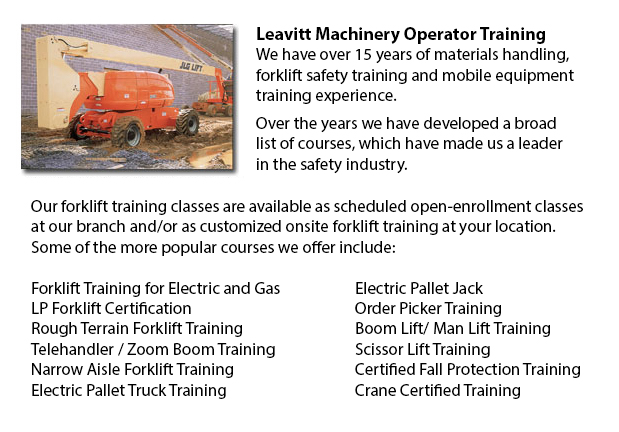
Aerial Lift Safety Training British Columbia - There are roughly 26 to 30 construction fatalities in North America due to the utilization of aerial lifts. Most of the individuals killed are craftsmen like for example electrical workers, laborers, painters, carpenters or ironworkers. The majority of the deaths are caused by falls, tip-overs and electrocutions. The greatest danger is from boom-supported lifts, such as bucket trucks and cherry pickers. Nearly all deaths are related to this particular type of lift, with the rest involving scissor lifts. Other risks include being struck by falling things, being thrown out of a bucket, and being caught between the lift bucket or guardrail and a thing, such as a joist or steel beam.
In order to safely operate an aerial lift, perform a check on the following items before making use of the device: operating and emergency controls, safety devices (such as, guardrails and outriggers), personal fall protection gear, and wheels and tires. Inspect for possible leaks in the air, hydraulic fluid and fuel-system. Check the device for loose or missing components.
The areas where worker will utilize the aerial device should be inspected carefully for potential dangers, like holes, bumps, debris and drop-offs. Overhead powerlines need to be monitored and avoided. It is suggested that aerial lift devices be utilized on surfaces that are stable and level. Do not work on steep slopes which go beyond slope restrictions that the manufacturer specified. Even on a level slope, brakes, wheel chocks and outriggers must be set.
Companies should provide their aerial lift operators with the right manuals. Operators and mechanics should be trained by a qualified individual experienced with the applicable type of aerial lift.
Aerial Lift Safety Guidelines:
o Close lift platform chains or doors prior to operating.
o Climbing on and leaning over guardrails is prohibited. Stand on the platform or floor of the bucket.
o Stay within manufacturer's load-capacity limitations.
o Utilize work-zone warnings, like for example signs and cones, when working near traffic.
Electrocutions are avoidable if safety procedures are followed. Stay as far away from power lines - at least 10 feet. Qualified electrical workers should insulate and/or de-energize power lines. Workers must make use of personal protective tools and equipment, like insulated bucket. However, an insulated bucket does not protect from electrocution if, for example, the person working touches another wire providing a path to the ground.
When inside the bucket, workers must prevent possible falls by securing themselves to the guardrails by using a positioning device or a full-body harness. If there is an anchorage in the bucket, a positioning belt with a short lanyard is adequate.
Tip-overs are preventable by following the manufacturer's instructions. Unless the manufacturer specifies otherwise, never drive when the lift platform is elevated. Follow the device's vertical and horizontal reach limits, and never exceed the load-capacity which is specified.
-
Warehouse Forklift Safety Training British Columbia
Warehouse Forklift Safety Training British Columbia - The corporation would face claims for liability when damage and injuries are sustained in an accident at the workplace. Warehouses can be a hazardous place to work for its workers, making employee... More -
Loader Operator Certification British Columbia
Loader Operator Certification British Columbia - Courses Offered For Getting Loader Operator Certification - Certification for forklifts are required to guarantee the safe operation of forklifts for those employers in industrial, warehouse or constru... More -
Crane / Overhead Crane / Self-Erect Crane / Truck Mounted Crane / Hydraulic Cranes Training in British Columbia
Bridge cranes or likewise called overhead cranes are actually a type of industrial material handling crane making use of a line and hook device that runs on a horizontal beam running along two widely separated rails. Numerous overhead cranes could be... More -
Scissor Lift License British Columbia
Scissor Lift License British Columbia - The operation of scissor lifts carries an inherent chance of danger. Whichever type of powered machine requires correct handling to prevent accidents causing injury or damage. Companies need to make certain tha... More -
Heavy Equipment Training Schools British Columbia
Heavy Equipment Training Schools British Columbia - There are a lot of heavy equipment training schools to select from. If you want to get to the best, it is important to check various aspects of the school in order to ascertain the level of educatio... More -
Telehandler Training British Columbia
Telehandler Training British Columbia - Telescopic handlers usually called telehandlers for short, are an extremely popular piece of heavy construction equipment. They are commonly utilized in the construction and agricultural trades. These machines... More -
Forklift Training Courses British Columbia
Forklift Training Courses British Columbia - When forklift operator safety training is tailored for illiteracy, training time is lessened by 50%. Forklift training certification, lift-truck operator driver safety training evaluation, and train the tr... More -
Heavy Equipment Operator Training British Columbia
Heavy Equipment Operator Training British Columbia - Heavy equipment operator training facilities which provide quality standards in the business, providing field performance work and added machinery training are highly sought after training features... More

Forklift Training British Columbia
TOLL FREE: 1-888-254-6157
forklifttrainingbritishcolumbia.com
Email Us
About Us


